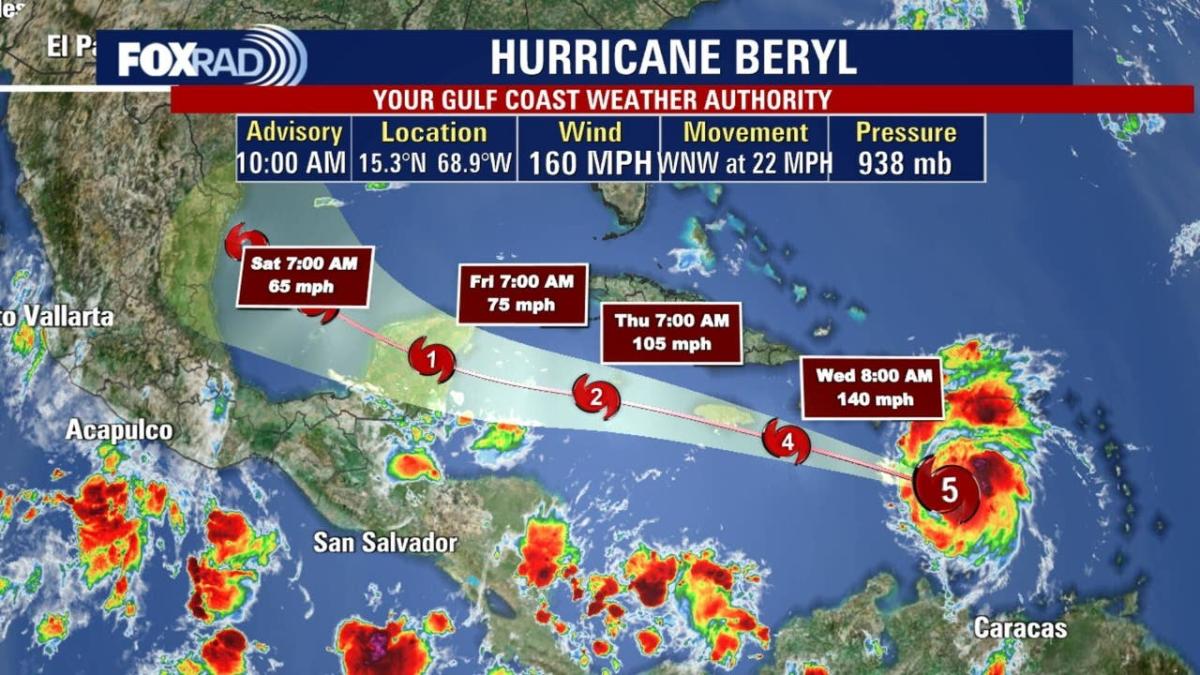Hurricane Beryl’s Path and Intensity
Hurricane beryl tracker – Hurricane Beryl is a powerful tropical cyclone that has been wreaking havoc across the Atlantic Ocean. It formed as a tropical depression on July 5th and quickly intensified into a hurricane on July 7th. As of July 10th, Beryl is a Category 4 hurricane with maximum sustained winds of 130 mph. The storm is currently located approximately 1,000 miles east-southeast of Bermuda and is moving west-northwest at 12 mph.
The relentless Hurricane Beryl continues to churn across the Atlantic, leaving a trail of devastation in its wake. Its path, meticulously tracked by weather experts, is eerily reminiscent of the trajectory of James Wood , the rising star of baseball.
Like the hurricane, Wood’s talent is undeniable, leaving opponents in awe as he carves a path through the league with astonishing speed and precision. As Beryl approaches landfall, so does Wood’s ascent to the pinnacle of the sport, promising to leave an indelible mark on the game.
Beryl’s path is expected to continue west-northwest for the next few days. The storm is expected to pass well east of Bermuda on July 11th and then turn more northward. Beryl is expected to weaken as it moves over cooler waters, but it is still likely to be a powerful hurricane when it approaches the coast of Nova Scotia on July 13th.
As Hurricane Beryl barrels through the Atlantic, another storm is brewing on the gridiron. Jalen Hurts , the dynamic quarterback, is making waves with his electrifying play. Like the relentless force of Beryl, Hurts is carving a path of destruction through opposing defenses, leaving a trail of broken records and shattered hopes in his wake.
As Beryl approaches landfall, Hurts is poised to unleash his fury upon the football field, leaving an unforgettable mark on the NFL landscape.
Factors Influencing Beryl’s Movement and Intensity
Several factors are influencing Beryl’s movement and intensity, including:
- Wind patterns: The prevailing wind patterns in the Atlantic Ocean are steering Beryl west-northwest. As the storm moves northward, it will encounter stronger winds that will push it more to the north.
- Ocean currents: The warm waters of the Gulf Stream are providing Beryl with the energy it needs to maintain its intensity. As the storm moves over cooler waters, it will begin to weaken.
- Atmospheric conditions: The atmosphere around Beryl is relatively stable, which is allowing the storm to maintain its strength. However, if the atmosphere becomes more unstable, Beryl could weaken more rapidly.
Potential Impacts of Hurricane Beryl
![]()
Hurricane Beryl poses significant threats to the areas it is projected to impact. Understanding the potential impacts is crucial for timely preparation and risk mitigation.
The geographic areas most likely to be affected by Hurricane Beryl include the Caribbean islands, particularly the Bahamas and Turks and Caicos Islands, as well as the southeastern coast of the United States, specifically Florida.
Storm Surge
Storm surge is a major concern associated with Hurricane Beryl. It refers to the abnormal rise in sea level caused by the hurricane’s strong winds and low atmospheric pressure. Storm surge can lead to severe flooding in coastal areas, damaging infrastructure, homes, and businesses.
High Winds
Hurricane Beryl is expected to bring high winds, which can cause widespread damage. These winds can uproot trees, damage buildings, and disrupt power lines. High winds can also create dangerous flying debris, posing a significant hazard to life and property.
Flooding
Heavy rainfall associated with Hurricane Beryl can lead to flooding. This flooding can inundate low-lying areas, making roads impassable and causing damage to homes and businesses. Flash flooding can also occur, posing a risk to motorists and residents in affected areas.
Landslides
In areas with steep terrain, Hurricane Beryl’s heavy rainfall can trigger landslides. Landslides can block roads, damage infrastructure, and pose a threat to life and property.
Measures to Mitigate Risks
To mitigate the risks associated with Hurricane Beryl, various measures are being implemented. These include:
- Issuing timely hurricane warnings and evacuating residents from vulnerable areas.
- Securing loose objects and reinforcing structures to minimize wind damage.
- Clearing drainage systems and preparing for potential flooding.
- Deploying emergency response teams and resources to affected areas.
Tracking Hurricane Beryl: Hurricane Beryl Tracker

Tracking the progress of Hurricane Beryl is crucial for staying informed about its potential impacts and taking necessary precautions. Numerous resources are available to help individuals stay up-to-date on the storm’s movement and intensity.
Weather Websites, Hurricane beryl tracker
Weather websites such as the National Hurricane Center (NHC) and AccuWeather provide real-time updates on Hurricane Beryl’s location, wind speed, and projected path. These websites offer detailed hurricane tracking maps, satellite imagery, and expert analysis.
Mobile Apps
Mobile apps like the NHC Hurricane app and the Weather Underground app offer convenient access to hurricane tracking information. These apps provide push notifications for updates on the storm’s movement and potential impacts, allowing users to stay informed even when they are away from a computer.
Social Media Platforms
Social media platforms such as Twitter and Facebook are valuable sources of information during hurricanes. Official accounts like the NHC and local emergency management agencies provide regular updates and share important safety tips. Following these accounts ensures individuals receive the latest information and can connect with others affected by the storm.
